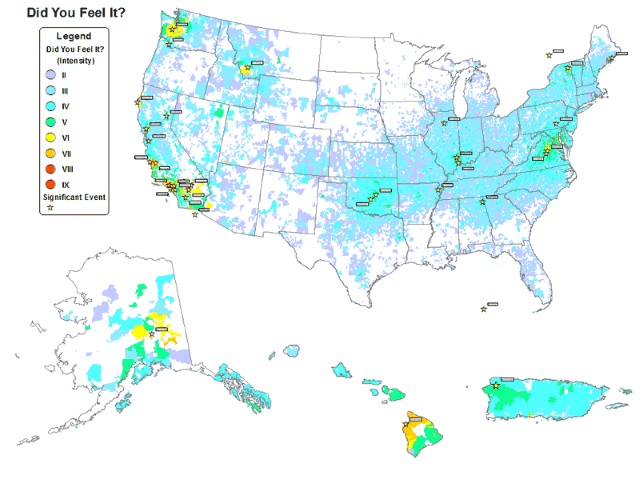
by Jennifer Georgek Thursday, August 21, 2014
Occurrences of earthquakes in the Central and Eastern United States have increased since 2009 — a phenomenon that many scientists attribute to the growing use of hydraulic fracturing for fossil fuel extraction. Most agree that it’s not the fracturing itself, but the reinjection of wastewater into wells for containment beneath the surface that tends to induce seismic activity. Now, new research looking at the effects of induced seismic activity suggests that human-made earthquakes and naturally occurring tectonic earthquakes are felt differently at the surface.

Cumulative map showing all the reports on the Did You Feel It? website in the U.S. from 1991 to 2013. Credit: U.S. Geological Survey.
To better understand hazards related to injection-induced earthquakes, Susan Hough, a seismologist at the U.S. Geological Survey (USGS) in Pasadena, Calif., examined ground shaking generated by 11 suspected injection-induced events occurring between 2011 and 2013 in five states in the Central and Eastern U.S. Hough used spatial intensity data for each earthquake from the USGS’ “Did You Feel It?” (DYFI) system, an online database through which individuals report the effects they experienced at their location. The DYFI system “uses an old idea of determining intensities based on how an earthquake was felt,” Hough says. “Intensity reflects how strongly the ground shook in any one location.”
Typically, intensity data are obtained instrumentally; however, in regions such as the Central and Eastern U.S., where seismic monitoring stations are sparse, the DYFI system is especially important, Hough says, because “every person who responds is essentially a human seismometer.” The popularity of the DYFI system makes it a relatively “reliable indicator of shaking severity.” DYFI records for tectonic events have been used to develop intensity prediction equations for various regions. This allows for the calculation of a magnitude that, on average, would result in a given intensity distribution — how the earthquakes were felt at a given distance from the epicenter. Hough labels this estimated magnitude the “effective intensity magnitude.”
For the 11 earthquakes examined in the study, which was published in the Bulletin of the Seismological Society of America, Hough found that the quake intensities decreased with distance from the epicenter — a pattern that is consistent with the behavior of tectonic earthquakes occurring in the same region. However, the intensities that were actually felt from these induced events corresponded to effective intensity earthquake magnitudes that were, on average, 0.82 magnitude units lower than the magnitudes measured by seismometers. For example, Hough says, “if an induced earthquake is a magnitude 5.0, the shaking is generally consistent with a magnitude 4.2. This observation held except within 10 kilometers of the epicenter — “and then the shaking levels are more consistent with expectations.” The latter result suggesting that shaking intensities are consistent close to the epicenter is likely explained by the earthquakes’ shallow depth, Hough says.
The research shows that “the shaking generated [by injection-induced earthquakes] is much lower than you’d expect for tectonic earthquakes of the same magnitude,” Hough says. As a result, “the hazard from induced earthquakes is not quite as bad as it may seem,” which is “reassuring to some extent.”
“The analysis that was done [by Hough] was robust, and the results are indicative of some systematic difference between the induced and tectonic earthquakes,” says Robert Graves, also a seismologist at USGS in Pasadena but who was not involved in the research. Still, Graves says, “there’s always room for improvement … as we have additional earthquakes, and more data comes to light, results may need to be reinterpreted.”
Another concern, says Cliff Frohlich, associate director of the Institute for Geophysics at the University of Texas at Austin, is the study’s reliance on such broad regions. “In the earthquake world, when people say ‘Eastern United States,’ they mean east of the Rockies,” he says, when realistically, there are “huge” differences from location to location even within a state. “Dividing the so-called Eastern U.S. into a number of other zones is going to be critically important if you’re going to understand the engineering implications of various earthquakes.” The differences presented in this study “may be simply explained by better models of how earthquakes affect the surface in different geological environments,” he says — something that can be answered by studying the subsurface in these regions to identify characteristics that may affect earthquake behavior.
If further research finds the same results — that the shaking generated by these induced events is concentrated in the immediate vicinity of the epicenter — then this “may lead to another practical recommendation,” Hough says: “to keep the injection wells at a certain distance from population centers” in order to minimize damage.
© 2008-2021. All rights reserved. Any copying, redistribution or retransmission of any of the contents of this service without the expressed written permission of the American Geosciences Institute is expressly prohibited. Click here for all copyright requests.